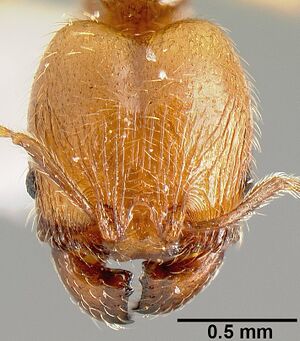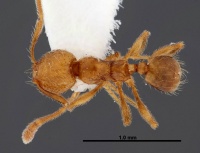Pheidole sparsisculpta
| Pheidole sparsisculpta | |
|---|---|

| |
| Scientific classification | |
| Kingdom: | Animalia |
| Phylum: | Arthropoda |
| Class: | Insecta |
| Order: | Hymenoptera |
| Family: | Formicidae |
| Subfamily: | Myrmicinae |
| Tribe: | Attini |
| Genus: | Pheidole |
| Species: | P. sparsisculpta |
| Binomial name | |
| Pheidole sparsisculpta Longino, 2009 | |
This species occurs in mature wet forest, from 50–1100m elevation. It is only known from the Barva Transect in Braulio Carrillo National Park, Costa Rica. Minor workers are moderately abundant in Winkler and Berlese samples of leaf litter from the forest floor, and there are occasional major workers associated with the minors. (Longino 2009)
Identification
With the morphometric profile and general habitus of Pheidole debilis. Minor worker: face and mesosoma with extensive smooth areas versus completely foveolate (debilis). Major worker: posterior fourth of face smooth and shining versus vertex lobes with faint reticulate rugose-foveolate sculpture extending almost to posterior border (debilis). (Longino 2009)
Distribution
Latitudinal Distribution Pattern
Latitudinal Range: 10.4° to 10.26667°.
| North Temperate |
North Subtropical |
Tropical | South Subtropical |
South Temperate |
- Source: AntMaps
Distribution based on Regional Taxon Lists
Neotropical Region: Costa Rica (type locality).
Distribution based on AntMaps
Distribution based on AntWeb specimens
Check data from AntWeb
Countries Occupied
| Number of countries occupied by this species based on AntWiki Regional Taxon Lists. In general, fewer countries occupied indicates a narrower range, while more countries indicates a more widespread species. |

|
Estimated Abundance
| Relative abundance based on number of AntMaps records per species (this species within the purple bar). Fewer records (to the left) indicates a less abundant/encountered species while more records (to the right) indicates more abundant/encountered species. |

|
Biology
Castes
Worker
Minor

| |
| . | |
Major
    
| |
| . | |
Queen
Images from AntWeb
   
| |
| Paratype Pheidole sparsisculpta. Queen (alate/dealate). Specimen code jtlc000014132. Photographer J. Russ, uploaded by California Academy of Sciences. | Owned by JTLC. |
Nomenclature
The following information is derived from Barry Bolton's Online Catalogue of the Ants of the World.
- sparsisculpta. Pheidole sparsisculpta Longino, 2009: 77, fig. 22 (s.w.) COSTA RICA.
Unless otherwise noted the text for the remainder of this section is reported from the publication that includes the original description.
Sequence data from the “dna barcode” region of mitochondrial gene CO1 place this species very close to or even within Pheidole debilis. Thus this is a situation worth further investigation, where there appear to be two morphological clusters in sympatry, yet sequence data suggest conspecificity.
Description
Worker
Minor Measurements (paratype): HL 0.51, HW 0.46, HLA 0.17, SL 0.44, EL 0.08, ML 0.57, PSL 0.07, PMG 0.00, SPL 0.03, PTW 0.08, PPW 0.13, CI 91, SI 95, PSLI 14, PMGI 0, SPLI 6, PPI 159.
Measurements (n=10): HL 0.45-0.54, HW 0.41-0.49, SL 0.39-0.47, CI 90-93, SI 93-98.
Mandible and clypeus smooth and shining; face sculpture highly variable, largely smooth and shining with variable development of weak rugulae and foveolae; posterior margin of vertex flattened; occipital carina narrow, not visible in full face view; scape with abundant subdecumbent setae, none of which are longer than maximum width of scape; promesonotal groove very shallow, indistinct; propodeal spines present; mesosoma sculpture similar to face in variability, generally shiny, pronotum entirely smooth and shiny or with faint rugulae and foveolae, katepisternum and lateral and dorsal faces of propodeum faintly foveolate; abundant setae on promesonotal dorsum; dorsal (outer) margin of hind tibia with abundant subdecumbent pilosity, all shorter than maximum width of tibia, no long erect setae; first gastral tergum smooth and shining; gastral dorsum with abundant erect setae; color orange.
Major Measurements (holotype): HL 1.05, HW 0.95, HLA 0.29, SL 0.52, EL 0.12, ML 0.75, PSL 0.09, PMG 0.01, SPL 0.06, PTW 0.15, PPW 0.34, IHT 0.17, OHT 0.41, CI 91, SI 55, PSLI 9, PMGI 1, SPLI 6, PPI 226, HTI 40.
Measurements (n=2): HL 1.03-1.05, HW 0.95-0.97, SL 0.48-0.52, CI 91-94, SI 50-55.
Mandibles smooth and shiny; clypeus smooth and shallowly concave, with shallow anterior notch; face with widlely-spaced longitudinal rugulae on cheeks and between frontal carinae, fading to smooth and shiny on posterior third of face; head with abundant suberect setae projecting from sides of head in face view; scape smooth and shining, terete at base, with subdecumbent pubescence and scattered longer suberect setae; hypostomal margin flat; median tooth small; inner hypostomal teeth pointed, stout, closer to midline than to outer hypostomal teeth; promesonotal groove impressed; propodeal spines present; pronotum largely smooth and shining, with a few transverse carinulae dorsally; katepisternum and propodeum generally shiny, with a few irregular rugulae and patches of faint foveolae; dorsal (outer) margin of hind tibia with short decumbent pilosity, no long erect hairs; pilosity abundant on mesosomal dorsum; postpetiole in dorsal view strongly transverse, with prominent lateral conules; first gastral tergite smooth and shining, with abundant flexuous erect setae; color orange brown.
Type Material
Holotype major worker. Costa Rica, Heredia: 16km SSE La Virgen, 10.26667°N 84.08333°W, ±2000m, 1100m, 20 Feb 2001 (ALAS#11/B/BH/047) Instituto Nacional de Biodiversidad, unique specimen identifier INB0003214434].
Paratypes: major and minor workers. Same data as holotype; same locality as holotype but 14 Mar 2001 (ALAS#11/WF/02/19), 19 Mar 2001 (ALAS#11/WF/03/19); Costa Rica, Heredia: 16km SSW Pto. Viejo, 10.31750°N 84.04889°W, ±500m, 500m, 20 Apr 2007 (Gilberth H and Felix C.#AMI-3-W-135-06) Field Museum of Natural History, Instituto Nacional de Biodiversidad, John T. Longino Collection, Museum of Comparative Zoology, National Museum of Natural History.
Etymology
The name is in reference to the sparse sculpture of the minor worker, compared to the similar P. debilis.
References
- Longino, J.T. 2009. Additions to the taxonomy of New World Pheidole. Zootaxa 2181: 1-90. PDF
References based on Global Ant Biodiversity Informatics
- Longino J. T. 2009. Additions to the taxonomy of New World Pheidole (Hymenoptera: Formicidae). Zootaxa 2181: 1-90.
- Longino J. T., and R. K. Colwell. 2011. Density compensation, species composition, and richness of ants on a neotropical elevational gradient. Ecosphere 2(3): 16pp.

